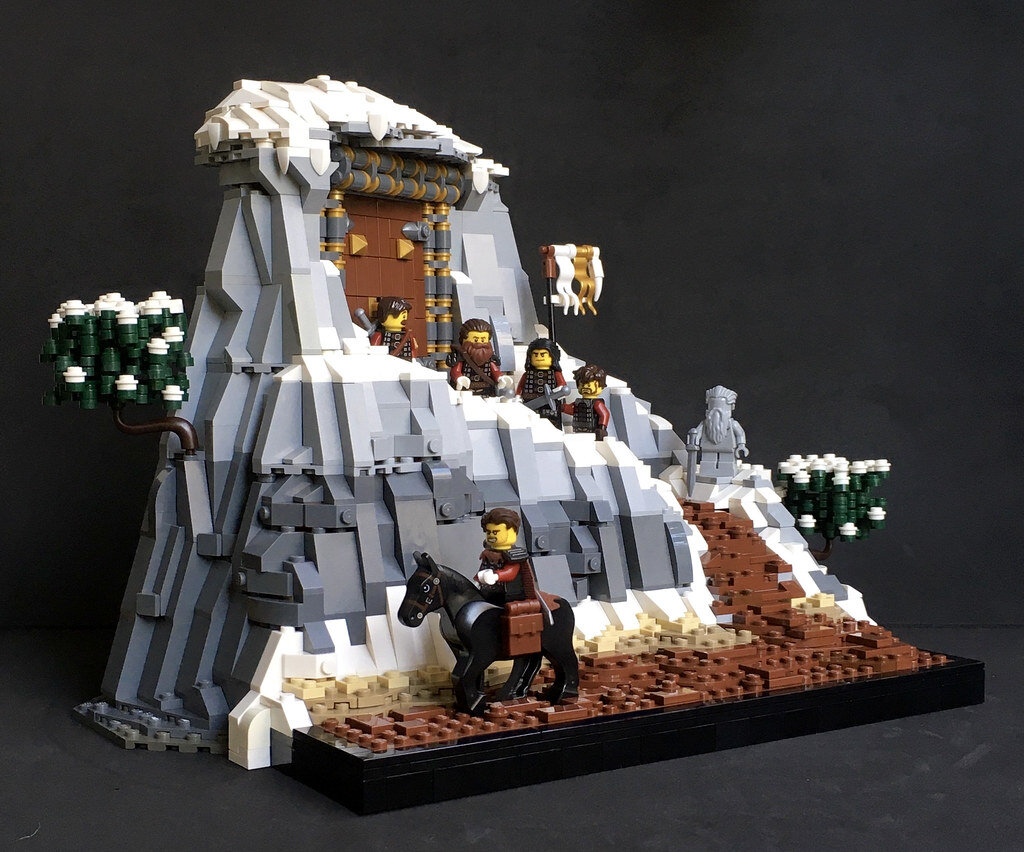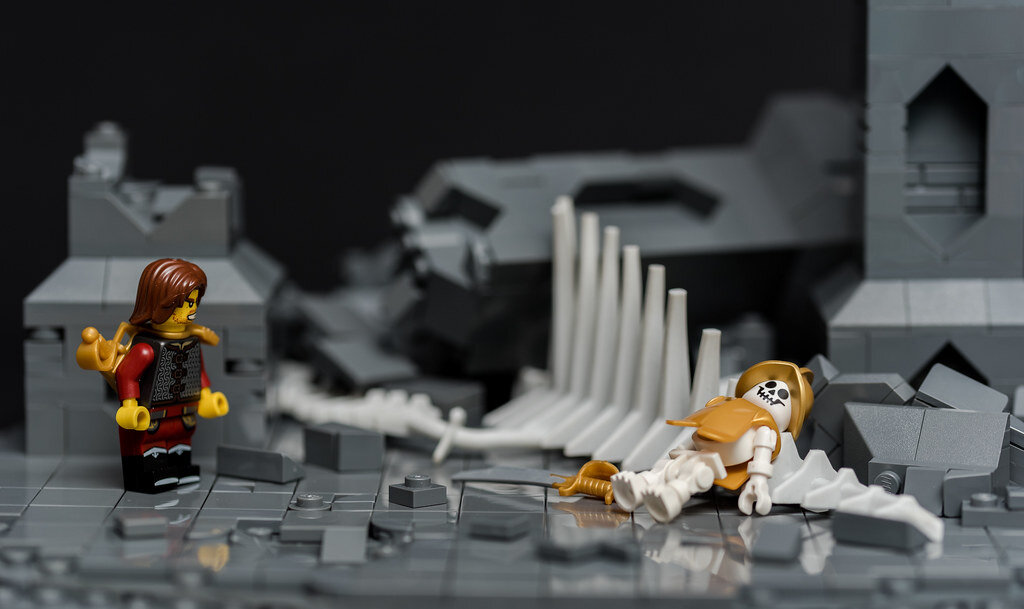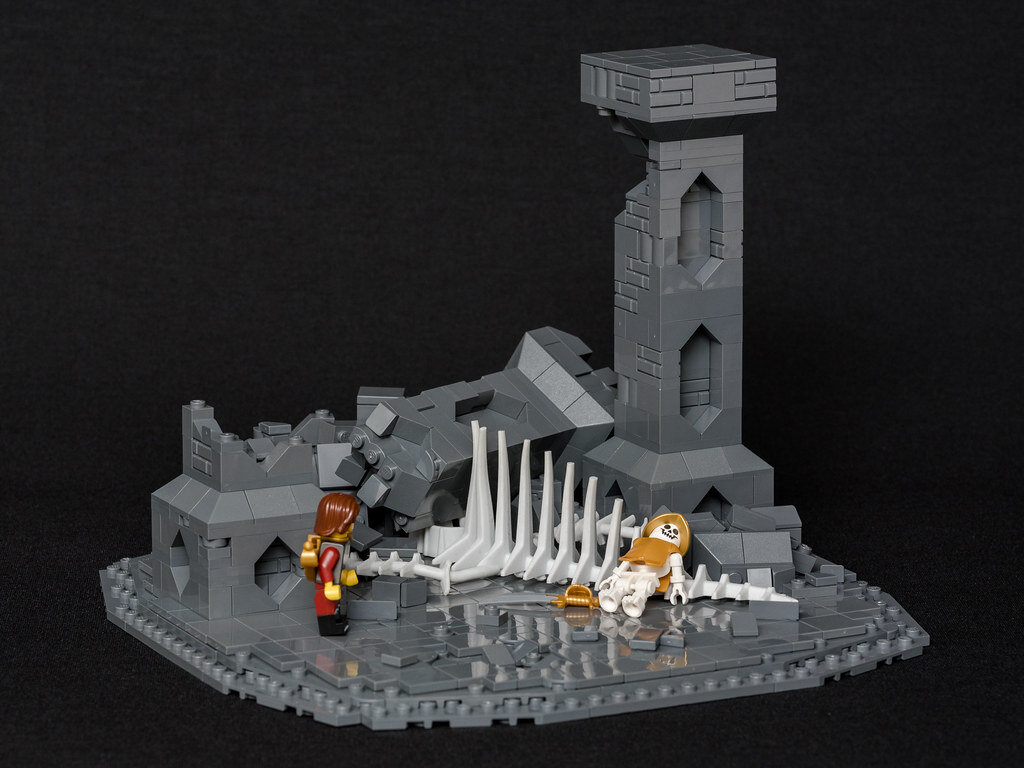Sea Serpents and Castle Keeps: A Chat with a LEGO Storyteller, Part 2
/Last week, we chatted with Louis of Nutwood, an up-and-coming LEGO builder from Brazil. He had so many stories that we now bring you the second part of our conversation with him where he shares his tips to building a LEGO scene that tells a story.
Isaiah: Last time we chatted, you mentioned that having a story in mind before you build can lead to inspiration. Can it also be a limitation? I love the fact that limited LEGO collections often force us to come up with creative solutions. Also, do your stories ever change mid-build?
Louis: Ooh, yes. It’s frustrating at first, yes, but the necessity of adapting, rebuilding, and reimagining—it feels like walking into the unknown with the confidence of knowing “you've got this.” It’s exciting, only because limitations are creativity at its core. It’s coming up with a solution that I didn't know was there, but—hey, yes! It is there! It might not be as huge or exactly the way you imagined, but in the end, I always know I could not have done better with what I had available. And it is simply fulfilling.
Isaiah: I know of few things more fulfilling than running up against that seemingly insuperable barrier of limitations and then finding a way through it where the limitations have actually made your original idea better. That’s definitely something that keeps a lot of us coming back to the LEGO desk (or bed or floor or wherever you build).
Louis: The limitations and the walls we face while building—those are basically what make us push harder and grow (insert a metaphor for life here, ha).
Isaiah: For Guilds of Historica, you mentioned last time that the whole story usually comes to you first before you build. Is that always the case? Do you write out any story arcs ahead of time or compose them as you go along? Or do you start your character off and let the winds and waves (and challenges) take them where they’re destined to adventure?
Louis: Hmm. Good question. For the purpose of collaboration (the most recent challenge on the Guilds was my first collab), it was definitely easier to have all the arc and characters lined up and thought out before we started building. For other challenges, here’s how it goes: I have a loose story I would like my character to go through (the keyword here is “loose”). If the challenge on the Guilds can be adapted to the loose story I’m thinking about, awesome, and they both come along together nicely.
If not, I’ll struggle to find a middle ground. Normally for larger arcs, I have an idea of how it will start, but absolutely no idea how it will end. And that’s pretty exciting. To not know is really to trust the character to make his own decisions, and as a writer, to simply report what happens—which is awesome!
Chapter 9 of the Louis of nutwood storyline
Isaiah: That’s something like my approach to it as well, although I tend to always write out what I’ve got in my head only once the build is being published (which I sometimes feel makes it too rushed, but ah well). I know some people plan out huge storylines, but when you want to participate in challenges, I’ve found that the best thing to do is to be flexible enough to be ready to ride on whatever adventure gets thrown at you! It’s a bit like real life that way too.
Louis: Ooooh, yes! Very much like life, haha. I feel we are tackling some philosophical topics covered by a LEGO theme. And having a fully written story only to figure out you will run out of bricks... that’s when the frustration kicks right in. All these metaphors are beautiful!
Isaiah: That’s one of the things that is so awesome about LEGO and storytelling–the way they can both reflect the truth about so many things in life that become so much clearer and more real when you think of them in a certain way. If nothing else, the nearly infinite creative possibilities that are totally open with a relatively small collection of limited parts say so much about the design of our own minds… it’s flabbergasting.
Can you tell us a bit about how you convey your stories with your camera angles and posing? How important (or unimportant) are those kinds of things to you as a builder and storyteller?
Louis: I’ll be honest and say the photography part is the one aspect of LEGO I like the least. And then there’s the editing, which I’m also not a big fan of. But now I understand that the photography must meet some standards to at least look appealing.
Here are some storytelling tips I try to remember every time I photograph or edit a photo:
Always think of layers – i.e., the highest point of the building should be in the back and the lowest upfront, so that no part of the creation is blocked.
It’s usually best to photograph the MOC at an angle (not straight-on).
Minifigs draw attention. So normally, fewer minifigs are better.
Natural light goes a long way (even though I still use a customized studio in my restroom—the large mirrors bounce the lighting and it turns out pretty good).
If you can, use free editing software like GIMP or MS Paint to stretch the background to showcase the MOC more and to cover reflections and erase distractions. If needed you can occasionally enhance the colors.
Isaiah: What kind of photos do you take to best showcase a MOC?
Louis: I really like to take pictures of the whole creation (showing it as a vignette), as I believe it displays the whole model more like an art piece. And then I try to take pics from “inside” the MOC from the minifigure’s point of view. To me, THAT’s when the story kicks in—when the sense of depth and blurry distances appear in the pictures along with the minifig’s expression.
The keeper (and his mouse)
Isaiah: Yep, those “story shots” are lots of fun both to shoot and to see from other people—they help you be there in the story in a way that overviews just can’t quite do. Out of curiosity, what has been the longest story?
Louis: The longest? Definitely “The Rise and Fall of the Baiamontes” for the last challenge in the Guilds of Historica. I loved writing it. It started with the challenge prompt, “tell the story of one of the families in Varlyrio,” and I immediately wanted a family with no background whatsoever.




I learned what I could about Varlyrio (the geography, lore, economy, intrigues, social hierarchy, etc.) and started thinking about the story lurking behind this military-driven family. Two characters came along: Juan and Rufus, his son. First I wrote the main points of the plotline which revolved around the idea that “Rufus will go mad after losing his devoted-to-the-realm dad.” And it all came together beautifully. Varlyrio simply became real to me, as well as the characters and locations. Showing the relationship between father and son was very emotional and a beautiful thing to experience. I wanted to have this “I lost him!” feeling and to show “father” as a hero. And I’m thrilled to have put the story together.
Isaiah: What has been your favorite story so far?
Louis: My favorite story must be Jormungandr, the Sea Serpent just because it came very naturally and I was able to write about an ancient practice or cult in a “modern warfare tabletop game” of sorts (Decisive Action 4). I was very proud of that one as the build came up in one day, and the story was very quick too. I felt like I was just “onto it,” you know?
Isaiah: I know exactly how that feels. You almost have to act on it quickly so you don’t lose anything. Apart from your stories, which is your favorite build?
Louis: That’s a difficult one. I always feel like the latest is always the greatest! And right now, I’m super proud of Svart Dyr, the Black Dragon, even though I love some others too: The Mocha, Frostdjur, and Svalg Keep have a very special place in my heart.
Isaiah: Ah, I thought it might have been one of your creature builds—those are always imposing and very well built, and there’s something about creature building that seems to have even more intrinsic character than even a story-driven build without one. And I remember your keep! My first Mitgardian Keep from a long time ago now still brings back fond memories—so the moral of this for our readers must be, “Go join Mitgardia and build a keep and you won’t regret it!”
Louis: That sounds about right! Build a keep for Mitgardia. There’s no regret there!
Louis’ Mitgardian keep - where’s yours?
Isaiah: We’ve talked about some of your successes, but any great story needs a villain. What’s your greatest enemy—building block or writer’s block, perhaps?
Louis: Uuuh, my greatest enemy? Sorting bricks after photography! It takes soooo much time. Seriously. It’s the worst thing. I’m flooded with ideas I want to build, but noooo. I still have to sort those bricks after taking apart my MOC. Grrr.
Isaiah: Oomph. I know that’s the greatest enemy for a lot of builders, but I actually find sorting kind of addictive—as soon as I’ve finished and photographed a build, I literally can’t rest until no two pieces are left attached. Unfinished builds are more of my problem right now—I’ve got way too many of those lying around for one reason or another!
Louis: We do have a common enemy, then! Unfinished builds are definitely a problem around here, too. Valnotstrad, my sigfig (Louis of Nutwood)’s village has been in the works for over three years now. That’s ridiculous!
Isaiah: You started a book series build late last year with Agatha Christie inspiring your first. Any word on when you’ll be coming out with more?
Louis: Aah, yes! Books in Bricks! It started with the idea of a series that remained untouched after literally the first episode. There are just so many things to build! But yes, the second chapter (a Sci-Fi classic!) will come… eventually. I can’t promise any date, though.
Books in bricks! - Murder on the orient express
Isaiah: For our final round, some speed questions! Where do you live? What does your favorite greeting “Skol” mean? And what are your favorite books to get inspired by?
Louis: Hahaha! I live in Brazil, but I dream of moving to colder, snowy lands. Skol means “cheers” in Norwegian (read, Viking). And my favorite books to get inspired by are A Song of Ice and Fire series by G.R.R. Martin and Bernard Cornwell’s The Last Kingdom. I’m also addicted to Dan Brown’s formula in every book, José Saramago when life passes you by, and Stephen King for that kick of horror.
Isaiah: I’m from the States and am currently living in central Chile, and I dream of living somewhere with snow too! Is there anything else you’d like to share?
Louis: Anything else about me? If someone could put in a good word to The LEGO Group, I’d work for them in a heartbeat. Hahaha!
Isaiah: Well, thanks so much for your time, mate! I hope you’ve enjoyed this chat as much as I have, and I’m pretty sure that anyone who’s got enough patience to read through these two articles won’t be sorry! I’m looking forward to your upcoming builds and stories—never stop building or writing!
Louis: It was a true pleasure chatting with you, a fellow writer and Guild member! I had a blast. All the best, brother! Skol!
That ends our interview, but we’ll return to Nutwood for more stories from Louis again sometime! In the meantime, follow Louis on Flickr, Eurobricks, and Instagram to keep up with all his builds.
What are your favorite stories you’ve created for a MOC? Let us know in the comments below!
Do you want to help BrickNerd continue publishing quality articles like this one? Become a patron to show your support, get early access, exclusive swag and more.






















